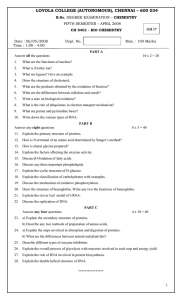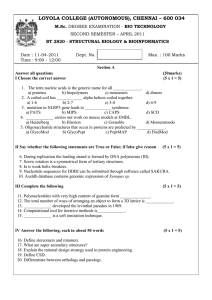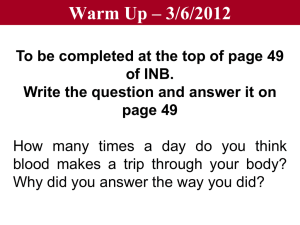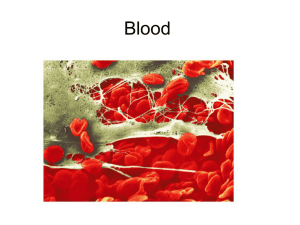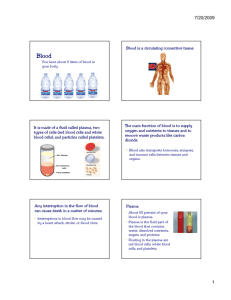BLOOD Cardiovascular System Chapter 19
advertisement
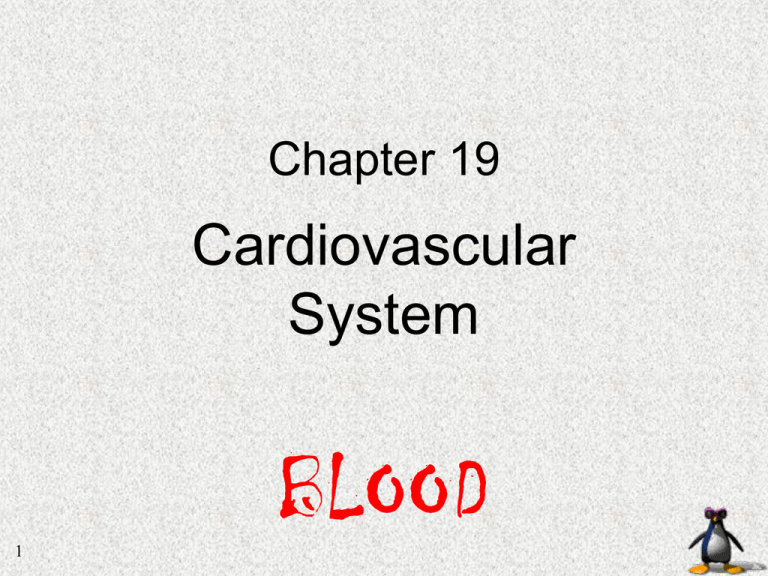
Chapter 19 Cardiovascular System 1 BLOOD Functions of Blood Transport – primary ‘highway’ & delivery system of the body Maintenance – maintains homeostasis Protection – immune system role 2 Blood Function - Transport Delivery of O2 & nutrients to body cells Removal of CO2 and other metabolic wastes Substances needed for maintenance & protection transported throughout body 3 Blood Function - Maintenance Homeostasis maintained: Blood buffers help maintain pH in body fluids excess heat transport to skin by blood blood clot formed when tissues damaged 4 Blood Functions - Protection Immune cells (white blood cells) label & attack foreign cells & substances such as microorganisms, parasites & toxins Clotting protects against fluid loss 5 Components of Blood Plasma – the fluid portion of blood (55% of volume) Formed Elements - cells & cell fragments (45% of volume) 6 7 Plasma Components 91% water 7% protein albumin globulins fibrinogen 2% other solutes ions nutrients gases waste hormones & other regulators 8 Formed Elements Cells & cell fragments 95% = Erythrocytes (red blood cells, RBCs) 5% = Leukocytes (white blood cells, WBCs) & Platelets WBCs include: neutrophils lymphocytes monocytes eosinophils basophils 9 Origins of Formed Elements Blood cell production is called Hemopoesis All cells & cell fragments come originate from a population of Stem Cells found in red bone marrow… Different stem cell lines include: Proerythroblasts red blood cells Myeloblasts granulocytes Lymphoblasts lymphocytes Monoblasts monocytes Megakaryoblasts platelets 10 Potentiality of Stem Cells Pluripotential – a cell with several possible outcomes Unipotential – a cell with a single possible outcome Stem cells are pluripotential and may become either of the previous cell types (see previous slide). Once their initial step is taken their ultimate destiny is locked. They are then unipotential. See figure 19.xxx on page xxx for possible choices for stem cell 11 12 13 14 15 Erythrocytes - RBCs NO NUCLEUS most common blood cell 5.2 million / mm3 in males 4.5 million / mm3 in females Shape = biconcave disk with thick edge & thin center imagine a round pillow with all stuffing forced away from center Filled with hemoglobin – carries O2 16 17 Hemoglobin Four proteins two alpha (α) two beta (β) Each protein binds a heme molecule containing an iron molecule heme is the portion of the molecule which attracts & carries O2 When carrying O2 hemoglobin is bright red & called oxyhemoglobin when O2 absent, darker red, deoxyhemoglobin 18 19 Developmental Changes in Hemoglobin Children & adults use ‘adult hemoglobin’ which is the least efficient O2 carrier Fetal hemoglobin is a more efficient O2 carrier & is used by the fetus WHY? This ‘stronger’ hemoglobin allows fetus to attract O2 from maternal blood across the placenta. Otherwise the fetus would not get enough O2. Embryonic hemoglobin is MOST EFFICIENT – this is used by very young embryo before implanting in uterine wall and allows scavenging of O2 from body fluids – EXTREMELY attractive for O2 20 Red Blood Cell Lifespan Stimulated by low blood levels of O2. Kidneys produce erythropoetin which causes marrow to produce erythrocytes. Stem cell – proerythroblast – erythroblast – reticulocyte – erythrocyte Typical RBC lives about 110 days (♀) - 120 days (♂) 21 Removal of Old RBCs Old or damaged cells are destroyed by macrophages in spleen, liver & lymphatic tissues. Enzymes break cells & digest hemoglobin. Heme broken into biliverdin then to bilirubin Free bilirubin is taken up by liver & conjugated Some leaves & is carried to kidney (urine) Most deposited by liver as part of bile into intestine. In intestine it is further broken down into pigments which color feces. Excess bilirubin in circulation colors skin yellow = jaundice 22 23 Leukocytes (White Blood Cells) Referred to as ‘white’ because they lack hemoglobin These cells serve as ‘body police’ & ‘garbage disposal’ cells to attack invaders & dispose of dead or dying cells. Many of these cells are motile (self-mobile) and move by extending part of the cell membrane and then flowing into the extension (amoeboid movement) In a specialized type of movement, diapedesis some of these cells become elongated & thin to leave the circulation and travel into tissues 24 Neutrophils Most common WBC Stain with both acid/base (doesn’t ‘prefer’ either stain) Nucleus has multiple lobes – “Polymorphonuclear cells” Short lifespan – about 2 days Leave bloodstream early in their life (10-12 hours old) Move into tissues where they are phagocytic (eating invading cells & ‘foreign’ substances) 25 Produce lysozymes – digestive enzymes to break down bacteria Eosinophils Cytoplasmic granules stain bright red with eosin (an acidic dye) These cells leave circulation in response to inflammation Increase in # during allergic response or parasite infection Mediate inflammation by producing enzymes to break down histamine Phagocytize antigen/antibody complexes (as do neutrophils) 26 Basophil Cytoplasmic granules stain blue or purple with basic dyes Least common WBC. Leave circulation & enter tissues in response to allergic reaction & inflammation. Release histamine to INCREASE inflammation Release heparin, an anticoagulant to inhibit blood clots 27 Lymphocytes Smallest WBCs – barely larger than RBC very little cytoplasm – sometimes just a thin halo around nucleus Originate in bone marrow but unlike most other blood cells they can divide outside bone marrow Multiple types of lymphocytes: B- Lymphs respond to bacteria & foreign substances by producing antibodies (protective proteins) T- Lymphs attack foreign cells & viruses 28 Monocytes Largest WBCs - leave circulation after about 3 days enter tissues to become macrophages (“big eaters”) where they engulf & destroy bacteria, damaged cells, foreign substances & debris May be increased during prolonged infections May process foreign substances & “show” these foreign components to lymphocytes. This activates lymphocytes which can ‘target’ the invaders. Much like police handing out photo of suspect 29 Platelets These cell fragments are produced when megakaryocytes (very large cells) break up. Lifespan of platelet is short, 5-9 days Contain actin & myosin which can produce contraction Membrane contains glycoproteins & proteins which function as attachment molecules Play large protective role by forming platelet plug to seal small breaks or by forming clots to seal larger damage 30 Platelet Plug Sealing small breaks in blood vessel walls 1) Von Willibrand’s Factor a collagen produced by endothelial cells in damaged vessel wall. Platelets bind to this material 2) Platelets activated to release adenosine diphosphate (ADP), thromboxanes & other chemicals which activate nearby platelets in a cascade effect. 3) Platelets produce surface receptors which bind fibrinogen (a plasma protein found in blood) which cross-links platelets to form a solid plug. 4) Production of Platelet factor III & Coagulation Factor V 31 32 Vascular Spasm A short term solution to larger damage – when a platelet plug is not enough Small blood vessels can contract smooth muscle in their walls closing off to prevent fluid loss. Produced in response to chemicals released during platelet plug formation (thromboxanes & endothelin) & by nerve reflex 33 Coagulation – Plugging Larger Holes Blood clotting – a meshwork of fibrin (fibrous protein) forms which traps blood cells & platelets preventing fluid loss. Mediated by a series of coagulation factors (see table 19.3) These factors normally circulate in blood but don’t clot unless activated. 34 Intrinsic Extrinsic Stage 1 Stage 2 Stage 3 35 Clot Control Anticoagulants produced to prevent uncontrolled clot growth/production Antithrombin (from liver) inactivates thrombin (slowly) Heparin (from basophils & endothelium) together with antithrombin inactivate thrombin (rapidly) Prostacyclin (from prostaglandin) stops platelets from releasing clotting factors & causes vasodilation 36 Clot Retraction & Dissolution Clots condense into a dense form by clot retraction as platelets contract (using actin & myosin). As the clot condenses it pulls the damaged edges together to promote healing and close gaps. Epithelial cells at wound margin divide and fill damaged space. Clot dissolves as fibrin is broken down (fibrinolysis) by plasmin (an enzyme) 37 Blood Grouping Red Blood Cells are ‘labeled’ with many types of cell surface proteins These proteins are a normal part of cell function - one role is labeling cells as ‘self’ so your immune system will not attack them. These label proteins and any other markers recognized by the immune system are called antigens. Antigens are markers (often proteins) recognized by the immune system. There are 35+ currently recognized antigen groups on RBCs 38 Antibodies Antibodies are immune system (blood serum) proteins which recognize specific antigens. Antibodies are VERY specific and will recognize and attach only to their unique antigens Once an antibody has recognized and attached to an antigen it can cause clumping or agglutination. Hemolysis (rupturing of red cells) is triggered by antigen/antibody attachment 39 ABO & Rh Blood Groups ABO blood group is the most commonly examined cell surface antigen when considering blood compatibility Rh is another cell surface antigen which is also considered – it is a different protein. Both of these groups of proteins are commonly examined in simple blood typing. Many other groups of blood cell surface markers (proteins) exist: Lewis, Duffy, Kidd, Lutheran… 40 ABO This family of proteins labels RBC surfaces. An individual may have the gene which makes protein type A May have the gene which makes protein type B May have one copy of each gene A & B May have a ‘dud’, defective gene which makes neither A nor B Remember – you get one copy of a gene from Mom and one from Dad so you have two ‘ABO’ genes 41 Genes Determine Blood Proteins Type A proteins (type A blood) are made if you have an A gene Type B proteins (type B blood) are made if you have a B gene Type A & B proteins are made in an individual who has one copy of each Type O IS NOT A PROTEIN – it is simply a lack of either A or B and occurs when you have two ‘dud’ defective genes. This isn’t a bad thing, it simply means you don’t have these cell markers – there are lots of others! 42 Genotype & Blood Type If your genes are 43 You have Blood Type A&A A A & -- A B&B B B & -- B A& B AB -- & -- O IMPORTANT INFO Your blood contains antibodies which will recognize as foreign, and ATTACK any blood antigen (eg. A or B) which you don’t normally make. Remember those A & B proteins label ‘self’ so your immune system doesn’t attack you…. If you don’t normally have the protein your body will think it foreign and ATTACK.. RULE OF THUMB – Never give someone a blood protein they don’t normally make. You CAN give them blood which has proteins they normally make OR which lacks proteins they make 44 45 First Patient with Type A blood gets a pint of Type A – a good match Second Patient with Type B blood gets a pint of Type B – a bad match 46 Who can donate to who? Two climbers – John (A) and Jenna (AB) are climbing Accident occurs Jenna needs blood – can John donate? John needs blood – can Jenna donate? Should their friend Phil (O) arrive what use might he be? 47 Donors & Acceptors Since you can not give anyone a blood group they don’t already have… Type O- (no A or B, no Rh) is said to be the ‘Universal Donor” Type AB+ is called the “Universal Acceptor” 48 Paternity with Blood Groups Since a child inherits ABO blood group genes from each parent they are useful in addressing question of parentage Mom type A Baby type AB Possible father #1 = blood type O Possible father #2 = Blood type B Mom could be either AA or A__ Father #1 is __, __ (couldn’t provide the B which we see in baby) Father #2 could be BB or B__ (might be father) 49 Population Distribution White Americans O -- 47% A -- 41% B – 9% AB – 3% 50 Black Americans O -- 46% A -- 27% B – 20% AB – 7% Rh factor Rh is simply another blood cell surface protein.. Where ABO has two blood proteins and four possible types (A, B, AB & O) this has only one protein (Rh) and two possible types (+ and -) If you have this protein you are said to be Rh positive, if you lack this protein you are Rh negative 51 52 Male 44-54% 53 Female 38-48% White Blood Cell Count normal values – 5000 – 10,000 cells per mm3 Leukopenia – fewer than normal WBC count Leukocytosis – higher than normal WBC count Leukemia (bone marrow cancer) can be one cause of leukocytosis as can infection 54 Differential Count Typical values for WBCs Neutrophil 60-70% Lymphocytes 20-30% Monocytes 2-3% Eosinophils 1-4% basophils 0.5-1% 55
